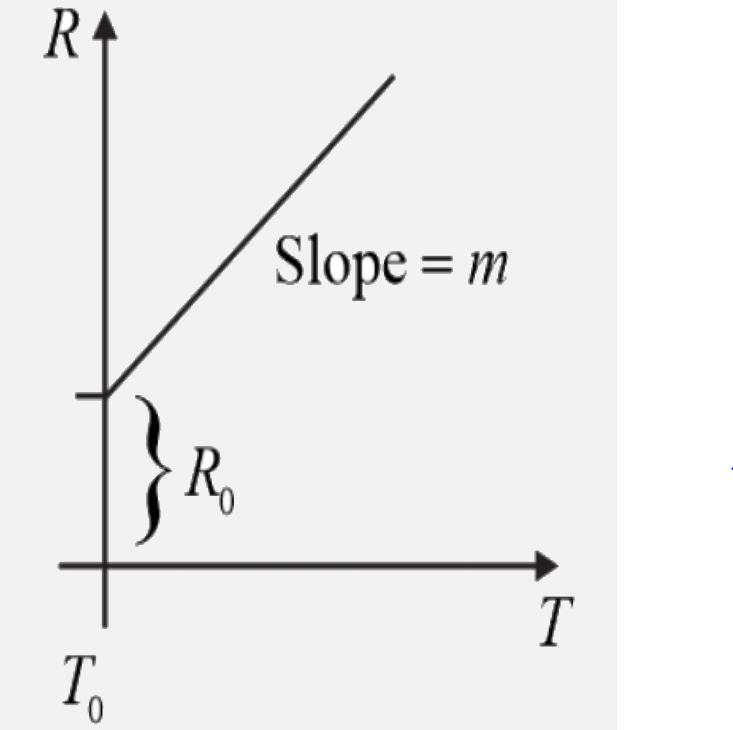A cylindrical conductor has a resistance R. When the conductor is at a temperature (T) above its surrounding temperature (T0), the ratio of thermal power dissipated by the conductor to its excess temperature (ΔT=T–T0) above surrounding is a known constant k. The conductor is connected to a cell of emf V. Initially, the conductor was at room temperature T0. Mass and specific heat capacity of the conductor are m and s respectively.
(i) find the time (t) dependence of the temperature (T) of the conductor after it is connected to the cell. Assume no change in resistance due to temperature.
(ii) find the temperature of the conductor after a long time.
The correct Answer is:(i) T=T0+V2kR(1−e−ktms)
(ii) T=T0+V2kR
To solve the problem, we will break it down into two parts as specified in the question.
Part (i): Find the time (t) dependence of the temperature (T) of the conductor after it is connected to the cell.
1. Understanding the Power Dissipation:
The power (P) dissipated in the resistor (conductor) when connected to a cell of emf V is given by:
P=V2R
2. Heat Transfer to Surroundings:
The thermal power dissipated by the conductor to its surroundings is proportional to the excess temperature (ΔT=T−T0). According to the problem, this can be expressed as:
Pdissipated=kΔT=k(T−T0)
3. Setting Up the Equation:
The power dissipated in the conductor equals the rate of heat dissipated to the surroundings:
V2R=k(T−T0)
4. Rearranging the Equation:
Rearranging gives:
T−T0=V2kR
Thus,
T=T0+V2kR
5. Heat Capacity and Temperature Change:
The change in temperature of the conductor can also be expressed in terms of its mass m and specific heat capacity s:
msdTdt=P−Pdissipated
Substituting for P and Pdissipated:
msdTdt=V2R−k(T−T0)
6. Rearranging for Separation of Variables:
Rearranging gives:
dTV2R−k(T−T0)=dtms
7. Integrating:
This is a separable differential equation. We can integrate both sides to find T(t). The left side involves a logarithmic function:
∫dTV2R−k(T−T0)=1ms∫dt
8. Solving the Integral:
The integration results in:
−1kln∣∣∣V2/R−k(T−T0)V2/R∣∣∣=tms+C
where C is the constant of integration determined by initial conditions.
9. Finding the Constant:
At t=0, T=T0:
C=−1kln|1|=0
10. Final Expression:
Thus, we can express T(t) as:
T(t)=T0+V2kR(1−e−kt/(ms))
Part (ii): Find the temperature of the conductor after a long time.
1. Long Time Condition:
As t→∞, the exponential term e−kt/(ms) approaches zero.
2. Final Temperature:
Therefore, the temperature T approaches:
Tfinal=T0+V2kR
Summary of Results:
- Part (i): The time dependence of the temperature T(t) is:
T(t)=T0+V2kR(1−e−kt/(ms))
- Part (ii): The final temperature of the conductor after a long time is:
Tfinal=T0+V2kR
The power (P) dissipated in the resistor (conductor) when connected to a cell of emf V is given by:
P=V2R
The thermal power dissipated by the conductor to its surroundings is proportional to the excess temperature (ΔT=T−T0). According to the problem, this can be expressed as:
Pdissipated=kΔT=k(T−T0)
The power dissipated in the conductor equals the rate of heat dissipated to the surroundings:
V2R=k(T−T0)
Rearranging gives:
T−T0=V2kR
Thus,
T=T0+V2kR
The change in temperature of the conductor can also be expressed in terms of its mass m and specific heat capacity s:
msdTdt=P−Pdissipated
Substituting for P and Pdissipated:
msdTdt=V2R−k(T−T0)
Rearranging gives:
dTV2R−k(T−T0)=dtms
This is a separable differential equation. We can integrate both sides to find T(t). The left side involves a logarithmic function:
∫dTV2R−k(T−T0)=1ms∫dt
The integration results in:
−1kln∣∣∣V2/R−k(T−T0)V2/R∣∣∣=tms+C
where C is the constant of integration determined by initial conditions.
At t=0, T=T0:
C=−1kln|1|=0
Thus, we can express T(t) as:
T(t)=T0+V2kR(1−e−kt/(ms))
As t→∞, the exponential term e−kt/(ms) approaches zero.
Therefore, the temperature T approaches:
Tfinal=T0+V2kR
- Part (i): The time dependence of the temperature T(t) is:
T(t)=T0+V2kR(1−e−kt/(ms))
- Part (ii): The final temperature of the conductor after a long time is:
Tfinal=T0+V2kR
Topper's Solved these Questions
Similar Questions
Knowledge Check
When the temperature of a metallic conductor is increased, its resistance
Aalways decreasesBalways increasesCmay increases or decreasesDremains constantWith decrease in temperature, resistivity of a conductor
AincreasesBdecreasesCremains the sameDfirst increases then decreasesThe temperature coefficient of resistance of a conductor is
APositive alwaysBNegative alwaysCzeroDInfinite
The temperature coefficient of resistance of a semi conductor is
View SolutionOn increasing the temperature of a conductor, its resistance increases because
View SolutionOn increasing the temperature of a conductor, its resistance increases because
View SolutionThe ratio of the resistances of a conductor at a temperature of 15∘C to its resistance at a temperature of 37.5∘C is 4:5. The temperature coefficient of resistance of the conductor is
View SolutionOn increasing the temperature of a conductor its resistance increases because
View Solution

